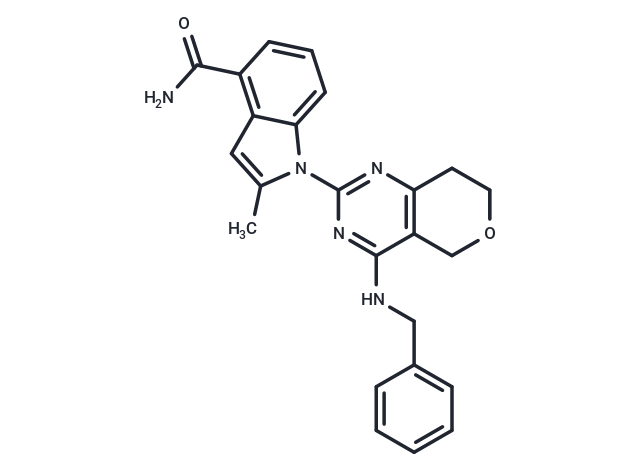Shopping Cart
Remove All Your shopping cart is currently empty
Your shopping cart is currently empty
CB-5083 is a potent, selective, and orally bioavailable p97 AAA ATPase inhibitor ( IC50=11 nM).

| Pack Size | Price | USA Warehouse | Global Warehouse | Quantity |
|---|---|---|---|---|
| 1 mg | $38 | In Stock | In Stock | |
| 2 mg | $54 | In Stock | In Stock | |
| 5 mg | $89 | In Stock | In Stock | |
| 10 mg | $139 | In Stock | In Stock | |
| 25 mg | $313 | In Stock | In Stock | |
| 50 mg | $493 | In Stock | In Stock | |
| 100 mg | $723 | In Stock | In Stock | |
| 500 mg | $1,520 | Inquiry | Inquiry | |
| 1 mL x 10 mM (in DMSO) | $98 | In Stock | In Stock |
| Description | CB-5083 is a potent, selective, and orally bioavailable p97 AAA ATPase inhibitor ( IC50=11 nM). |
| Targets&IC50 | p97 AAA ATPase:11 nM |
| In vitro | In A549 cells, CB-5083 causes significant K48 poly-ubiquitinated protein and CHOP accumulation as well as p62 reduction, and kills tumor cells with IC50 of 680 nM. [1] |
| In vivo | In mice bearing human HCT 116 colon tumor xenografts, CB-5083 (75 mg/kg, p.o.) significantly inhibits tumor growth. In mice bearing established human AMO-1 multiple myeloma and A549 lung carcinoma tumor xenografts, CB-5083 (100 mg/kg, p.o.) also results in significant tumor growth inhibition. [1] |
| Kinase Assay | ATPase assay: Compounds are diluted in DMSO with a 3-fold 10-point serial dilution starting at 10 μM. The assay is done in a 384-well plate with each row as a single dilution series with duplicate of each compound concentration point. In 5 μL total volume, 20 nM p97 hexameric enzyme and 20 μM ATP are added to start the reaction. The plate is sealed and incubated at 37 °C for 15 min after mixing thoroughly in an orbital shaker. Compound dilution, ATP and enzymes addition are conducted with automated liquid handling using the Freedom Evo. ADP Glo reagents 1 and 2 are added according to the manufacturer's protocol. The luminescence is measured by Envision plate reader as the end point of the reaction. The IC50 of each compound is derived by fitting the luminescence values to a four-parameter sigmoidal curve. |
| Cell Research | A549 and other tumor cell lines are cultured according to ATCC guidelines. Cells are cultured in black or white, clear-bottomed, tissue culture-treated 384-well plates. Cells are treated with 10-point dose titration of the compound in well duplicates. After a 72 h treatment, CellTiter-Glo is added to the white plates to measure cell viability. Luminescence values are fit to a four-parameter sigmoidal curve to determine IC50 concentrations.(Only for Reference) |
| Synonyms | CB5083, CB 5083 |
| Molecular Weight | 413.47 |
| Formula | C24H23N5O2 |
| Cas No. | 1542705-92-9 |
| Smiles | Cc1cc2c(cccc2n1-c1nc2CCOCc2c(NCc2ccccc2)n1)C(N)=O |
| Relative Density. | 1.37 g/cm3 (Predicted) |
| Storage | store at low temperature | Powder: -20°C for 3 years | In solvent: -80°C for 1 year | Shipping with blue ice/Shipping at ambient temperature. | ||||||||||||||||||||||||||||||||||||||||
| Solubility Information | Ethanol: 11 mg/mL (26.6 mM), Sonication is recommended. H2O: < 1 mg/mL (insoluble or slightly soluble) DMSO: 247.5 mg/mL (598.59 mM), Sonication is recommended. | ||||||||||||||||||||||||||||||||||||||||
| In Vivo Formulation | 10% DMSO+40% PEG300+5% Tween 80+45% Saline: 6 mg/mL (14.51 mM), Solution. Please add the solvents sequentially, clarifying the solution as much as possible before adding the next one. Dissolve by heating and/or sonication if necessary. Working solution is recommended to be prepared and used immediately. The formulation provided above is for reference purposes only. In vivo formulations may vary and should be modified based on specific experimental conditions. | ||||||||||||||||||||||||||||||||||||||||
Solution Preparation Table | |||||||||||||||||||||||||||||||||||||||||
Ethanol/DMSO
DMSO
| |||||||||||||||||||||||||||||||||||||||||
| Size | Quantity | Unit Price | Amount | Operation |
|---|

Copyright © 2015-2026 TargetMol Chemicals Inc. All Rights Reserved.